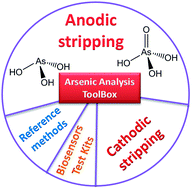Recent advances in electrochemical detection of arsenic in drinking and ground waters
Abstract
Anodic stripping voltammetry (ASV) using noble electrodes is based on the reduction of As3+ to As0, followed by its stripping or oxidation to As3+ or As5+ species, the two predominant forms of arsenic in water. The rapid and convenient ASV method can detect As(III) at the low ppb level, but it is susceptible to interferences from various endogenous metals or organic compounds in waters. Electrode surface modification with metallic nanoparticles (NPs), carbonaceous nanomaterials (carbon nanotubes and graphene) and even enzymes (arsenite oxidase) can improve detection sensitivity and selectivity, while circumventing such interferences. All electrochemical methods aim for a detection limit below the World Health Organization guideline value of 10 ppb (133.3 nM). Despite numerous publications in this field during the last ten years with respect to novel electrode materials and electrolytes, reproducibility of electrochemical detection is still problematic and the analysis of arsenic in real ground-water samples is far from certainty and triviality. Considerable efforts are still needed to develop electrode materials and analytical procedures for reliable detection of arsenic with sub-ppb levels in the presence of endogenous toxic metals and organics in water matrices.


 Please wait while we load your content...
Please wait while we load your content...